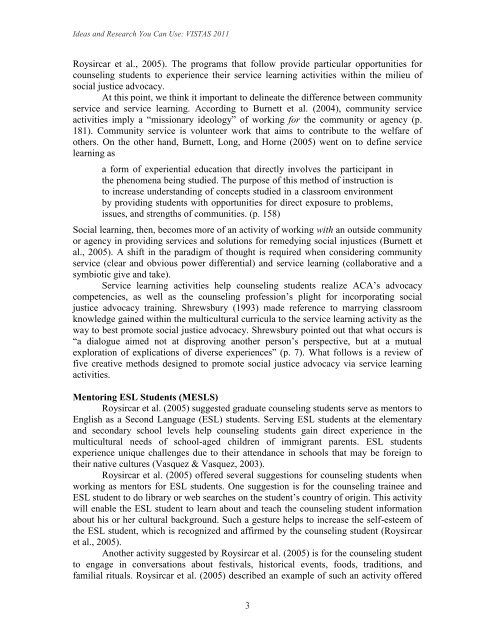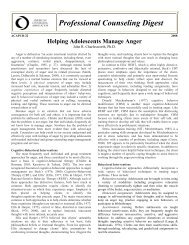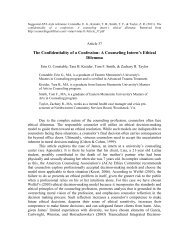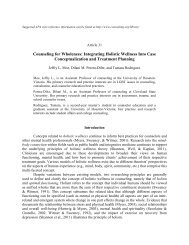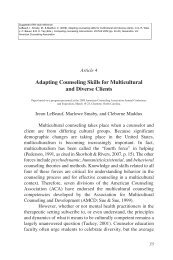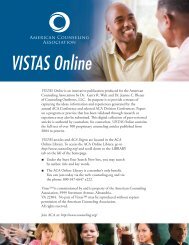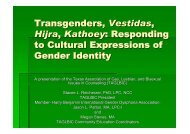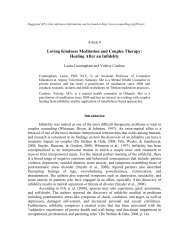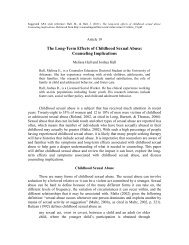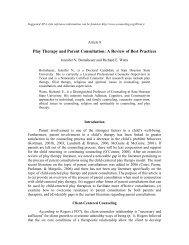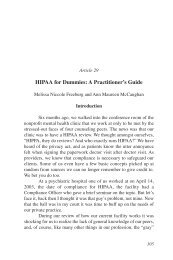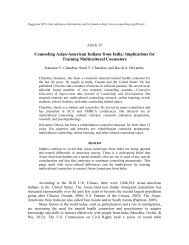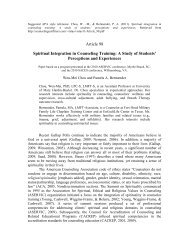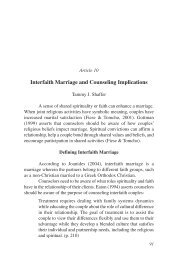Article 32. Teaching Social Justice Through Service Learning.
Article 32. Teaching Social Justice Through Service Learning.
Article 32. Teaching Social Justice Through Service Learning.
Create successful ePaper yourself
Turn your PDF publications into a flip-book with our unique Google optimized e-Paper software.
Ideas and Research You Can Use: VISTAS 2011Roysircar et al., 2005). The programs that follow provide particular opportunities forcounseling students to experience their service learning activities within the milieu ofsocial justice advocacy.At this point, we think it important to delineate the difference between communityservice and service learning. According to Burnett et al. (2004), community serviceactivities imply a “missionary ideology” of working for the community or agency (p.181). Community service is volunteer work that aims to contribute to the welfare ofothers. On the other hand, Burnett, Long, and Horne (2005) went on to define servicelearning asa form of experiential education that directly involves the participant inthe phenomena being studied. The purpose of this method of instruction isto increase understanding of concepts studied in a classroom environmentby providing students with opportunities for direct exposure to problems,issues, and strengths of communities. (p. 158)<strong>Social</strong> learning, then, becomes more of an activity of working with an outside communityor agency in providing services and solutions for remedying social injustices (Burnett etal., 2005). A shift in the paradigm of thought is required when considering communityservice (clear and obvious power differential) and service learning (collaborative and asymbiotic give and take).<strong>Service</strong> learning activities help counseling students realize ACA’s advocacycompetencies, as well as the counseling profession’s plight for incorporating socialjustice advocacy training. Shrewsbury (1993) made reference to marrying classroomknowledge gained within the multicultural curricula to the service learning activity as theway to best promote social justice advocacy. Shrewsbury pointed out that what occurs is“a dialogue aimed not at disproving another person’s perspective, but at a mutualexploration of explications of diverse experiences” (p. 7). What follows is a review offive creative methods designed to promote social justice advocacy via service learningactivities.Mentoring ESL Students (MESLS)Roysircar et al. (2005) suggested graduate counseling students serve as mentors toEnglish as a Second Language (ESL) students. Serving ESL students at the elementaryand secondary school levels help counseling students gain direct experience in themulticultural needs of school-aged children of immigrant parents. ESL studentsexperience unique challenges due to their attendance in schools that may be foreign totheir native cultures (Vasquez & Vasquez, 2003).Roysircar et al. (2005) offered several suggestions for counseling students whenworking as mentors for ESL students. One suggestion is for the counseling trainee andESL student to do library or web searches on the student’s country of origin. This activitywill enable the ESL student to learn about and teach the counseling student informationabout his or her cultural background. Such a gesture helps to increase the self-esteem ofthe ESL student, which is recognized and affirmed by the counseling student (Roysircaret al., 2005).Another activity suggested by Roysircar et al. (2005) is for the counseling studentto engage in conversations about festivals, historical events, foods, traditions, andfamilial rituals. Roysircar et al. (2005) described an example of such an activity offered3


